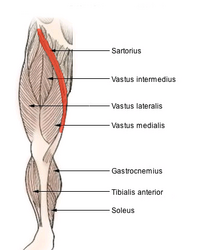
Photo from wikipedia
Objective To evaluate the relationship between femoral muscle volume (FMV) and physiological outcomes after trans-femoral amputations (TFAs) affecting overall locomotor function in patients. Methods Seven individuals who underwent TFA and… Click to show full abstract
Objective To evaluate the relationship between femoral muscle volume (FMV) and physiological outcomes after trans-femoral amputations (TFAs) affecting overall locomotor function in patients. Methods Seven individuals who underwent TFA and had been using a prosthesis participated in this cross-sectional study. Gait and balance were assessed using clinical tests, such as 10-m walk test, 6-minute walk test, Berg Balance Scale, and automatic balance system. Respiratory gas analysis was performed to check oxygen consumption rate. Five participants were evaluated for bilateral FMV by MR imaging and FMV was reconstructed using three-dimentional remodeling. Results In five participants, significant differences were found between the non-involved and involved sides in femur length, total FMV, and functional muscle volume (all p<0.01) in all groups except for the hip adductor volume. The %mean difference between the non-involved and involved sides was 30% for femur length, 52.55% for hip flexor volume, 26.55% for hip adductor volume, 51.86% for hip extensor volume, and 60.21% for knee extensor volume. The hip flexor volume to hip extensor volume ratio in the involved limb and oxygen consumption rate during comfortable gait were negatively correlated (r=-0.96, p=0.04). Conclusion In individuals who underwent unilateral TFA, hip girdle muscle imbalance in the involved limbs may be associated with oxygen consumption rate while using a prosthesis.
Journal Title: Annals of Rehabilitation Medicine
Year Published: 2022
Link to full text (if available)
Share on Social Media: Sign Up to like & get
recommendations!